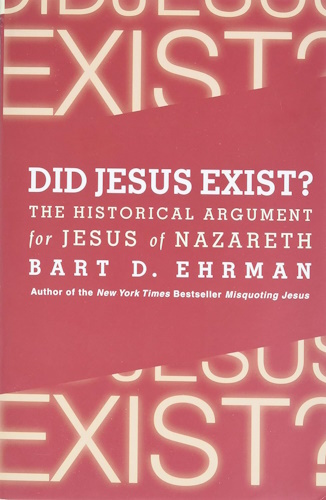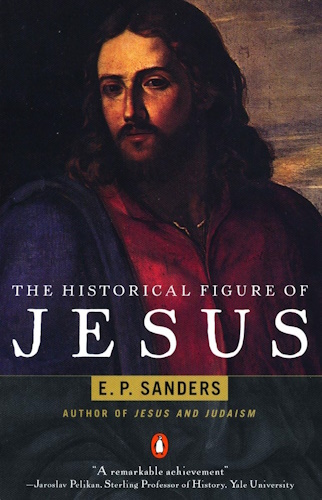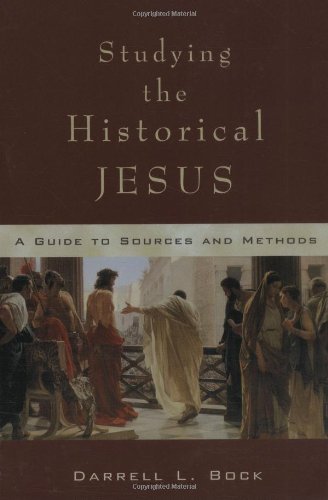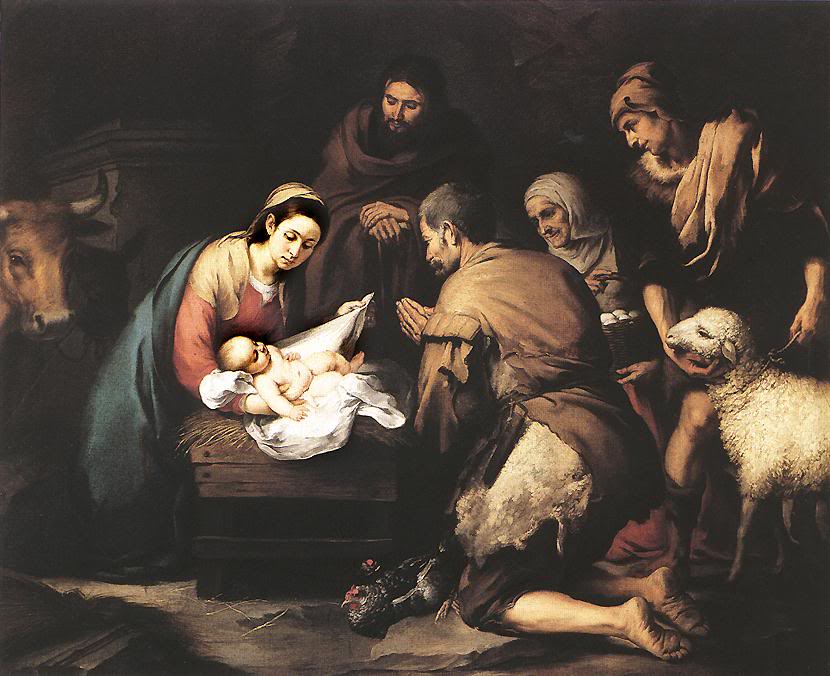![]()
History
And
The New Testament
by
Jack Kilmon
![]()
Jesus is born.
The date of Jesus' birth cannot be placed with certainty. One must do a little historical detective work to sort out the biblical references. This is assisted by Luke who mentions certain personages whose history is known. First among these is Herod the Great, King of Judea. Luke 1:5 places the announcement of the birth of John the Baptist "…in the days of Herod, King of Judea." The best historical evidence places the death of Herod shortly after an eclipse occurring on the night of Sunday, March 12/13, 4 BCE. and the Passover of Wednesday, April 11, 4 BCE. This corresponds to the year 750 A.U. of the Roman Calendar. Jesus was therefore born prior to 4 BCE.
The second person mentioned by Luke for this detective story is one "Cyrenius" who was Publius Sulpicius Quirinius, Roman soldier, senator and consul under Augustus. In 6 CE Quirinius was sent to Syria as legate along with Coponius who would be the first prefect of Judea and a predecessor of Pontius Pilatus. The registration and census of 6 CE is too late to be connected with the birth of Jesus. Additionally, the registration of 6 CE did not include the Galilee. This has long been a stumbling block in the determination of the date of Jesus' birth and many scholars merely assumed that Luke had made a mistake. In 1912,however, the discovery by W. M. Ramsey of a fragmentary inscription at Antioch of Pisidia arguably established Quirinius was in Syria on a previous occasion. (1) His role was more military to lead a campaign against the Homanadenses, a tribe in the Taurus Mountains. This is confirmed by Tacitus. This means that Quirinius would have established a seat of government in Syria, including Palestine, from the years 10 to 7 BCE. In this position he would have been responsible for the census mentioned by Luke. This census of 7 BCE would therefore have been the "first" census taken when Cyrenius was governor (Luke 2:2) and the historically documented census of 6/7 CE was really the second. There is further evidence of this first census of 7 BCE in the writings of Tertullian who records the census "taken in Judea by Sentius Saturninus." (2) C. Sentius Saturninus was Legate of Syria from 9 to 6 BCE. Another inscription, the Lapis Tiburtinus, was found in 1764 near Tivoli (Tibur). Composed after 14 CE, the inscription names an unknown personage who was legate of Syria twice. The man is described as having been victorious in war. There is considerable dissension among scholars as to whether the unnamed person is Quirinius. I think it is more likely that it refers to the famous consul and soldier.
Scholars have debated about the historicity of this first census since there is no record of it in the Roman archives. Their chief argument is that Augustus would not have imposed a census for the purpose of taxation in the kingdom of a client king like Herod. Herod had his own tax collectors and paid tribute to Rome from the proceeds. They further pose that the census in 6 CE was imposed because Herod's nutty son Archelaus had been deposed and Judea was placed under direct Roman rule. These are good arguments.
As a layman, I am forced to go back to Luke and ask why he would record an event that never took place. Luke was well educated with diversified talents. He seems careful in his historicity and, although very young at the time, may very well have met Jesus. He knew and interviewed those who were closest to Jesus. Some scholars think that the story of the first census and the birth in Bethlehem is theologoumenon. This is a term scholars use for that which expresses an event or notion in language what may not be factual but supports, enhances, or is related to a matter of faith. In other words, a "white lie." I don't buy it in this case. There is no advantage to matters of faith in the invention of a census of 6 BCE.
Some scholars argue that the early census was invented to support a mythological birth in Bethlehem in support of Messianic prophecy. We'll cover the Bethlehem issue below. As for the early census, I am inclined to believe Luke and Tertullian (even though Tertullian isn't one of my favorite characters). I can think of a number of reasons based on the history of the time. Lack of records is not evidence for or against an historical event. Records are lost and destroyed, particularly those that are two millennia old. Rome burned in 64 CE and there have been numerous conflagrations and sackings of the city over the centuries. Could Augustus had deviated from convention and imposed a census in Syria/Palestine in 6 B.C.E? Of course he could. He was the Emperor. Herod the Great was ill and, by all accounts of the time, nuttier than a fruitcake. He who had once been an able and effective administrator and builder, was now paranoid and vicious. He had murdered most of his family, including his sons and the wife he loved most. The joke in the Roman court by Caesar himself was that one was safer being Herod's pig than Herod's son. Josephus records in Antiquities of the Jews, XVI, ix 3 that Augustus was furious with Herod in 8 BCE and threatened to treat him no longer as a friend (Client), but as a subject (subject to taxes).
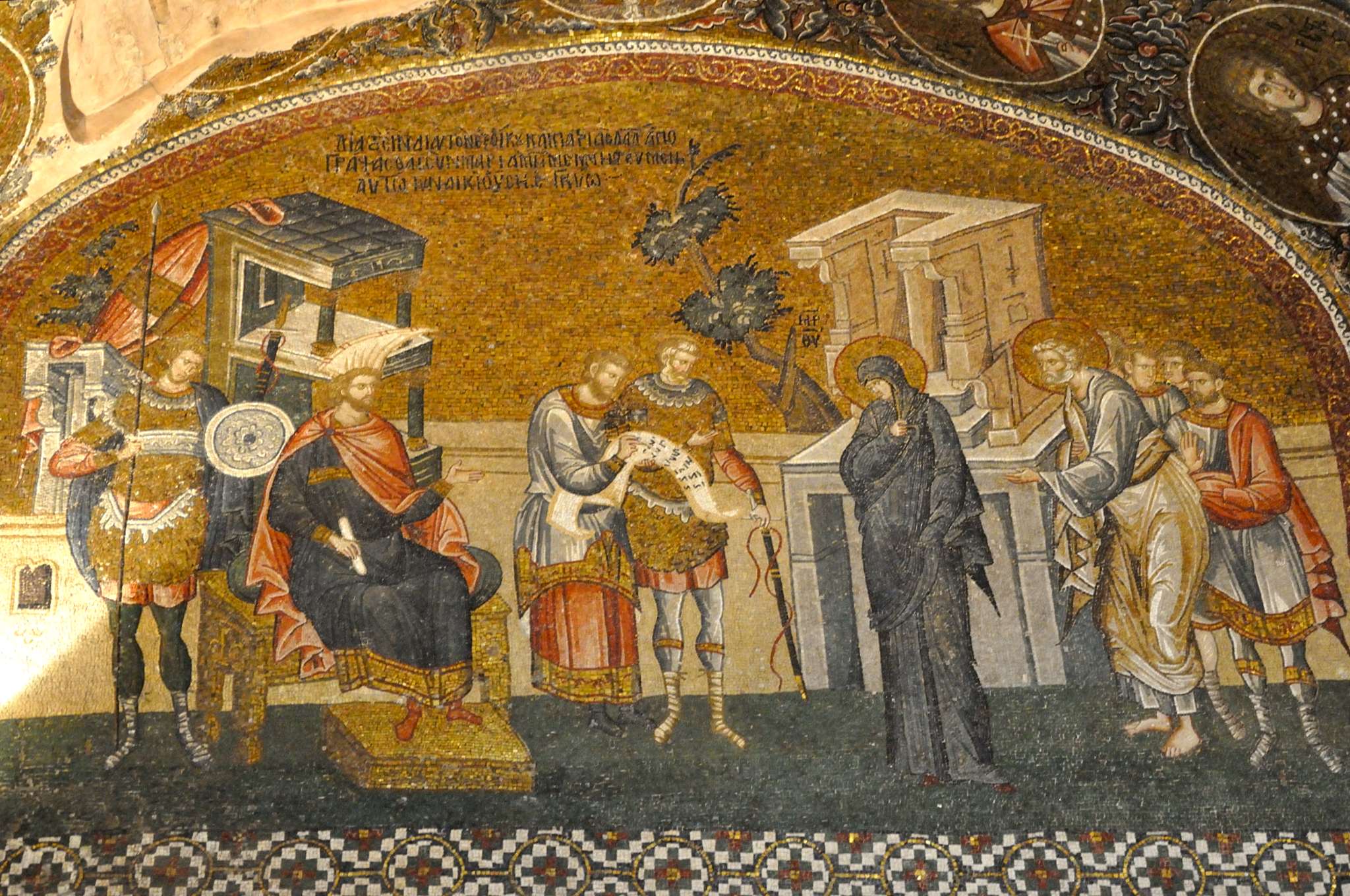
I believe that the prudent and prudish Augustus, scandalized by Herod's outrageous reputation and increasing madness, began the movement toward making Judea a prefecture in 8 BCE and part of that preparation was a registration. Caesar could have delayed actual imposition of direct rule in deference to Herod's ill health and the hope that his successor would not be as loony toony. When Herod died and Archelaus turned out to be crazier than his father, Augustus threw in the towel (or Toga) and made Palestine a prefecture. He sent Quirinius as Legatus (a second time) and Coponius as the first prefect. The census of 6 CE therefore becomes the first census under direct Roman rule and fell in schedule with the Roman census on a 14 year rotation. The census of Jesus' birth, perhaps only a registration, became lost in the archives. In this scenario, it would make sense to send Quirinius back as Legatus since he presided under the previous registration. Quirinius was no minor functionary. He was a Roman senator of the Equestrian order and had been consul since 12 BCE. He had won an insignia of triumph for the Homanadensian war and had accompanied Caesar to Armenia in 3 CE. He died in 21 CE.(3) Service in Palestine was not considered "prime duty" by Roman functionaries but the governorship of Syria was one of the most important positions in the Empire. The post was always given to the most respected and capable of Imperial functionaries chosen from the elite of Roman aristocracy. The Syrian Legatus was the commander-in chief of the entire Roman East and responsible for the Parthian border. I believe this Roman soldier, senator and administrator, who had already served Caesar well, returned to Syria as a personal favor for his emperor/friend. I must, therefore, be an audacious layman and disagree with the majority of New Testament scholars. I conclude that Luke is accurate.

Augustus Caesar..this youthful portrait in molded glass was issued On the occasion of his election as princeps (first citizen) in 27 BCE. He was about 56 years of age at the birth of Jesus.
Jesus' birth in the year 7 BCE would conform with the statements of Luke but what was the day of his birth?
Scholars are nearly unanimous that Jesus' birth did not occur on December 25 and on this I do agree. December 25 was the Roman festival day of Natalis Invictus, the birth of the Sun. The emperor Constantine, contrary to tradition, was not a Christian but an advocate of the cult of Sol Invictus. More for political expediency than for religious reasons, Constantine tolerated Jesus as an earthly manifestation of Sol Invictus, the son god. Since Christian doctrine was being promulgated by Rome, compromises were being made between Christianity, Sol Invictus and Mithraism. Constantine saw this as a way of maintaining harmony. An edict by Constantine in 321 CE ordered the courts to be closed on the "venerable day of the sun" and Sunday was chosen as the day of observance rather than the traditional Saturday Sabbath. If not on Christmas day, therefore, on what day was Jesus born?
The "Star of Bethlehem," Fact or Fiction?
Many biblical scholars have long contended the story of the "Star of Bethlehem" to be a myth, another of those theologoumenons (there's that word again). Astrology played an important role in the ancient Middle East, including the Jews. It would not be uncommon to correlate some celestial event with the birth of Jesus, just as the eclipse had been correlated to the death of Herod and a comet with the assassination of Julius Caesar in 44 BCE. No comets or Novae, "new stars," can be associated by astronomers with the period of Jesus' birth. Hence the source of the Star of Bethlehem remained a mystery or was considered myth.
In Prague, in 1603, shortly before Christmas, the astronomer and mathematician, Johannes Kepler, was making observations of the stars through his rudimentary telescope. He was observing the conjunction of Jupiter and Saturn in the constellation of Pisces. The two planets had converged to look like one larger and new "star." Kepler later remembered something he had read by the Rabbinical writer, Abravanel (1437-1508). Jewish astrologers maintained that when there was a conjunction of Saturn and Jupiter in Pisces, the Messiah would come. In ancient Jewish astrology, the constellation of Pisces was known as the House of Israel, the sign of the Messiah. Jupiter was the royal star of the house of David and Saturn was the protecting star of Israel, the Messiah's Star. Since the constellation of Pisces was the point in the heavens where the sun ended it's old course and began its new, it is understandable why this conjunction would be viewed as a portent of the Messiah.

Kepler concluded that he had found the "star of Bethlehem" but his hypothesis was rejected. It was not until 1925 that the hypothesis was re-examined when references to this conjunction were found in the cuneiform inscriptions of the astrological archives of the ancient School of Astrology at Sippar in Babylonia. Sippar was an ancient Sumerian city lying on a canal which linked the Tigris and Euphrates rivers. It was a very important commercial and religious center. Excavations at the site of Abu-Habbah during the latter part of the 19th century unearthed the remains of a temple and ziggurat dedicated to Shamash and the ancient scribal School of Astrology. The most important discovery were tens of thousands of clay tablets from the school archives that dated from the Old Babylonian and Neo-Babylonian periods. In 1925, the German Scholar P. Schnabel found, among the endless cuneiform records of dates and observations, a note on a conjunction of Jupiter and Saturn in the constellation of Pisces. The position of Jupiter and Saturn, converged in Pisces, had been recorded over a period of five months in 7 B.C.E!! Calculations show that the conjunction was observable three times over the course of the year, May 29, October 3, and December 4.
The conjunction in Pisces is observable in the southern sky over Judea and would sit directly over Bethlehem if one were observing along the road leading from Jerusalem to Bethlehem. Matthew 2:2 stating "We have seen his star in the east" is a mistranslation of the Greek phrase EN TH ANATOLH "in the east" from the original wording which means idiomatically, "the first light of dawn" (which comes from the east) when the conjunction is visible. The correlation of this celestial event with the first visit of Quirinius and a preliminary registration in Syria is too much of a coincidence for this layman to ignore. I must therefore humbly and respectfully disagree with the majority of New Testament scholars who again contend that the story of the Star of Bethlehem is another of those little "white lies." I conclude again, therefore, that the Gospel account is accurate.
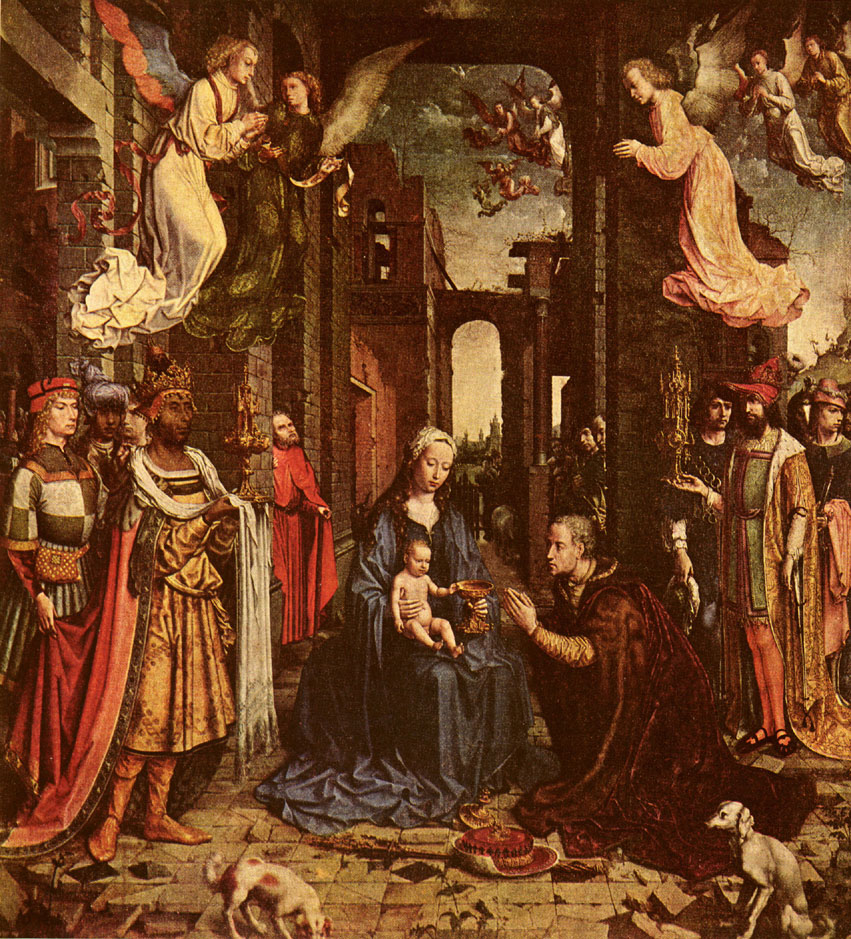
Accepting the Star of Bethlehem as an historical fact, our detective work gives us three possible dates for the birth of Jesus, May 29, October 3, and December 4 in the year 7 BCE. I would rule out May 29 as too early. Scholars also contend that the Gospel account of the three "Wise Men" is another of those theologoumenon white lies. If one were to accept the story of the three magi (astrologers), or at least three visitors who came to Judea based on the astrological omen, as containing an element of fact, May 29 is too early. Why would "wise men," astrologers/magi in Babylon care about a celestial event predicting the Jewish Messiah? Christians are normally unaware that Babylon was as important a center for Judaism as Jerusalem in the ancient world. It is the center for the predominating Babylonian Talmud. It is very likely that the "wise men" were scholars of the School of Astrology in Sippar and likely of Jewish ancestry dating to the mass deportations of Jews to Babylon in the 7th century BCE. Steeped in their Jewish messianic hopes and in astrology, these men would have been convinced that the birth of the Messiah was imminent. Given their background, an expedition to the Homeland would seem the most likely course of action for validation of both their scholarly, astrological and religious prognostication. These astrologers would have observed the first conjunction on May 29 and then made preparations to travel to Judea, arriving for the time of a predicted second conjunction. October 3 intrigues me because it is within days of the time of other recorded Roman censuses. Including the one in 6 CE. December 4 would be too late for Shepherds to be tending their flocks. These were usually brought in around the first of November. I must therefore again, with all respect to the New Testament scholars, disagree that the Gospel story of the Wise Men from the East is fiction. In this historical detective story, correlating the Gospel accounts of the registration with the celestial phenomenon, I choose Saturday, 10 Tishri, 3755 (October 3, 7 BCE.) as the date of the birth of Jesus. Interestingly, that day was a Yom Kippur, the Day of Atonement.
Where was Jesus Born?
The Infancy Narratives of Matthew and Luke often conflict. In the second chapters of both gospels, each author supports Bethlehem as the place of Jesus' birth. The overwhelming opinion of New Testament scholars again is that this is another theologoumenon (that's such a pretty word). These scholars claim that Jesus was born in Nazareth and that the Bethlehem story was invented to conform to Messianic expectations found in Micah 5:1:
"But thou, Bethlehem Ephratah, though thou be little among the thousands of Judah, yet out of ye shall he come forth unto me that is to be ruler in Israel; and his goings forth are from ancient time, from days of old."
Old rabbinical expectations of the Messiah arising from Bethlehem may also be reflected in the Midrash Rabbah and in Berakoth 5a of the Jerusalem Talmud. These writings, however, are much later than the time of Jesus and may not necessarily reflect Jewish expectations of the first century. In other words, it may not have been that big of a deal at the time of Jesus nor in the century following the crucifixion that the Messiah had to be born in Bethlehem. Jewish polemic against Jesus in the latter half of the first century featured attacks on his legitimacy but did not deny his birth in the City of David. If he had not been born in Bethlehem, I doubt if the rabbinic polemicists would have let it lie. This layman must therefore again disagree with many scholars and conclude that the Gospel account is accurate. It is this layman's conclusion that:
YeSHUa bar YoSEF (Jesus) was born on Yom Kippur, October 3, 7 BCE in the village of Bethlehem during a registration instituted by Augustus on an occasion when he was enraged at Herod's behavior. This registration was overseen by Publius Sulpicius Quirinius and was a preliminary to a direct Roman taxation. The taxation from this registration in 7/6 BCE was delayed as a result of Herod's age and health. The even more outrageous behavior of Herod's successor, Archelaus, who was deposed, and infighting among the other Herodian scions, convinced Augustus to institute a praefecture and the first official Roman census and taxation in 6 CE and to liquidate the estate of the deposed Archelaus.(4) It is this official first census in Syria that confuses scholars regarding the birth of Jesus since Quirinius again was sent by Caesar as legate under the new prefecture. Coponius accompanied Quirinius and was the first prefect.
A Rebellion in Galilee during Jesus' youth
The institution of Judea as a prefecture and the enactment of this second registration in preparation for the first direct Roman taxation stimulated a revolt in the Galilee by one Judas of Gamala who would be the founder of the Zealot party. The Pharisaic party was divided and consisted of two "houses." The House of Hillel followed the milder and more liberal teachings of that great rabbinic sage (30 BCE -10 CE) and the House of Shammai, the harsher and more conservative opponent of Hillel. Jews in Galilee, angered by Roman oppression and this new taxation, rallied under the banner of Judas and Tsadok, a deputy of the House of Shammai. They attacked the two Roman legions sent from Syria to suppress the rebellion and were soundly defeated. As a result, two thousand zealots, including, Judas, were crucified and about 6,000 young Galileans were deported to slavery in the western empire.(5)
Almost certainly this event had a considerable influence on the young Jesus. It would have occurred at approximately the same time that the Gospels record the 12 year old Jesus taking his vows at the Temple. Friends of the family, as well as relatives, may have been sent to slavery in the west. Most seem to have been sent to Spain and Sardinia. Are these deported and enslaved relatives and friends of Jesus' on his mind as "the lost sheep of the house of Israel" (Mt. 10:6) and when John (10:16) records him saying , "..and other sheep I have, which are not of this fold; them also I must bring, and they shall hear my voice?" One of the traditions of Apostolic journeys is Jesus' own cousin, James, the "greater," the older of the sons of Zebedee, going to Spain and Sardinia. Returning to Jerusalem for the Passover of 44 CE, James was executed by Herod Agrippa. It is not inconceivable that Rome had put James on Agrippa's "hit list" as a result of his stirring "dissension" among the Jewish slaves. Tied with the taxation and the resulting rebellion, the year 6 must be considered an important influence on Jesus, promulgating his later invectives against some of the Pharisees (the House of Shammai) and certainly against the Sadducees who were Roman collaborators and led by the Roman appointed High Priest.
Jesus' Childhood
The only mention of Jesus' childhood in the Gospels is the 12 year old Jesus at the temple (Luke 2:41-51). To those familiar with the Jewish customs and practices of the time, Y'shua had reached the age of making vows (6)and the age of discrimination.(7) We know nothing about the rest of the childhood of Jesus. Known aspects of the cultural, social, family, and religious habits of first century Judea and Galilee allow us to make educated guesses about the upbringing and development of the young Jesus. We can be certain that he struggled with the same physical, sexual, intellectual and spiritual matters that are normal to the maturation of all young males throughout human history. In this all too familiar journey from child to adult, he would have developed a sense of his identity, a definition of self. Whether that early sense of self would include a concept of his own ultimate purpose and destiny, we cannot know. All we can do is look at those internal family elements typical for a Galilean family of the time and the external environment of the Galilee of Jesus. We know that he was of noble Semitic lineage and he was raised in a family business of Tektons. He had four younger brothers and at least two younger sisters, an issue we'll cover below.
Jesus' trade
Matthew 13:55 describes Jesus as "The carpenter's son," O TOU TEKTONOS UIOS, tekton being rendered as "carpenter" in translation. The Aramaic would have be berah d'nagora. More accurately, it is an artificer who could work in wood, fabric, masonry, sort of a general contractor or builder. Certainly carpentry would have been the most common undertaking. As the oldest son, Jesus would have been important to the family business and each of the sons may have had a specialty. The Galilee and the Decapolis (Ten City region) was an area of intense building projects and probably supplied more than enough work for the family. Tradition has it that Jesus was famous in this farming region for his yokes and to own one was a point of pride. There is no actual reference to Jesus himself as a carpenter and the earliest papyri refer to him as the Carpenter's son.
Some scholars suggest that Jesus was not a carpenter himself but was, in fact, a magician, having learned magic in Egypt. This is an ancient argument going back to early polemic against Christians and is mentioned by the second century Christian apologist, Justin Martyr(8) and the second century Platonist, Celsus. Celsus work, an attack on Christianity has not survived but was answered around 247 CE by the Christian apologist, Origen.(9) The opinion that Jesus was not a carpenter, but a magician, is expressed in an impressive modern study by Morton Smith.(10) The viewpoint that the author of Matthew invented the story of the sojourn into Egypt to provide an argument against the polemic against Jesus as an Egypt-educated Magician (another of those "white lies") is another scholarly opinion that this layman cannot accept. In first century Galilee, the oldest son would almost certainly follow the trade of his father.(11) I believe that the young Jesus worked at his father's side and with his brothers in the family contracting business until he launched his ministry. That Jesus waited until the year 26 or 27 to begin his mission suggests to me that Joseph had died and it was no longer a demonstration of disrespect to leave the family trade. Giving all due respect to the learned scholars, this layman must again conclude that the Gospel account is correct.
Jesus' Language
We cannot tackle the more difficult issue of what Jesus' exact words were without a better understanding of the language in which it was rendered. The Gospels and books of the New Testament were set down in Greek between 20 and 80 years after they were spoken. Greek was the vernacular of the West and the language of commerce. The vernacular of the East, and Jesus' language, was Aramaic.
The Hebrew language in first century Palestine was used for scriptural and scholarly writings. The weekly synagogue readings (the Sidra, Parashah, and Haphtarah) were always accompanied with an Aramaic translation. These oral translations of the Hebrew lections to Aramaic would eventually be written down in the Targumim. The Gemara of the Jerusalem Talmud and the Babylonian Talmud were written in Eastern (Babylonian) Aramaic.
Why did the Jewish people speak Aramaic and not Hebrew? Aramaic was the language of commerce of the Persian Empire and was used widely from the Indus Valley to Egypt. It became the language of the Jewish people by conquest first when the Israelites were deported by Tiglath-Pileser III in 732 BCE in the first Assyrian invasion. The northern tribes were deported in 721 B.C.E. when Sargon II made Israel an Assyrian province and finally the Judeans were deported in 587 B.C.E. by Nebuchadnezzar. There is, in a sense, some irony to this since these Mesopotamian conquerors came from the land that gave birth to Abraham. Aramaic was the language of the ancestor of the Jewish people. What is known as the Hebrew Language in the New Testament was called the Lip of Canaan in the Old Testament. Abraham and the Patriarchs adopted the language and script of the Phoenicians. The aftermath of the Babylonian Captivity resulted in a readopting of the Aramaic ancestral language of Abraham. The "Hebrew" script used today is actually the Aramaic Square Script, which replaced the Phoenician script known as "Old Hebrew" about 200 B.C.E. Old Hebrew is exemplified by the Moabite stone inscription, the Lachish letters, and the Siloam inscription. Most Christians are surprised to learn that until the adoption of Hebrew as the official language of the State of Israel in 1948, it had not been the vernacular of the Jewish people for over 2500 years.
Jesus' name in his own Aramaic language was Y'shua bar Yosef (Ye-SHOO-ah bar Yo-SEF). He spoke Aramaic when he preached or had conversations with his family, friends, and disciples. He would have used Hebrew in conversations with religious leaders and is recorded in the Gospels reading the Hebrew scriptures of Isaiah in the synagogue at Nazareth (Lk. 4:16-19). As a tradesman, working with his father and brothers on various building projects, he would have had to have some knowledge of Greek, the language of commerce. It is debated by scholars whether or not he was fluent in Greek or used it for any purpose outside of trade. It is this author's belief that he was well-educated, functioned well in Hellenistic surroundings, and probably was fluent but may have considered it the "gentile tongue" and eschewed it for common usage.
What type of Aramaic did Jesus speak? Aramaic ceased to be a uniform language during the anti-Semitic period of the Hellenistic Seleucids prior to the Maccabean revolt. During this period various dialects began to form on a regional basis, each with variations in pronunciation and vocabulary. These influences caused Aramaic to divide into a Western Branch with several dialects and an Eastern Branch with its dialects. The five periods of Aramaic, dating from 1000 B.C.E., are as follows:
Old Aramaic 1000 BCE to 700 BCE.
Imperial (Official) Aramaic 700 BCE to 200 BCE.
Middle Aramaic 200 BCE to 200 CE.
Late Aramaic 200 CE to 700 CE.
Modern Aramaic 700 CE to present
Jesus spoke the Galilean dialect of Middle Western Aramaic. The Galilean dialect was recognizable by Judeans much as a deep south dialect of English is recognized in the United States. Likewise, the Galilean dialect was considered provincial by the Judeans. Galileans had a tendency to drop the gutturals much like the Cockney "Enry" for Henry. An initial aleph was usually dropped, which explains why Jesus' good friend Alazar was called `Lazar by Jesus and eventually Latinized in the Vulgate to Lazarus. It is also why Simon Peter was recognized as a Galilean outside of the house of Caiaphas.
After a little while the men standing there came to Peter. "Of course you are one of them," they said. "After all, the way you speak gives you away!" Matthew 16:73
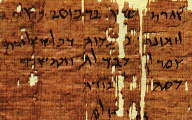
An Aramaic letter from Simon bar Kochba to Yehonathan bar Be'aya, written during the Jewish revolt 132-135 CE.
Jesus’ Education
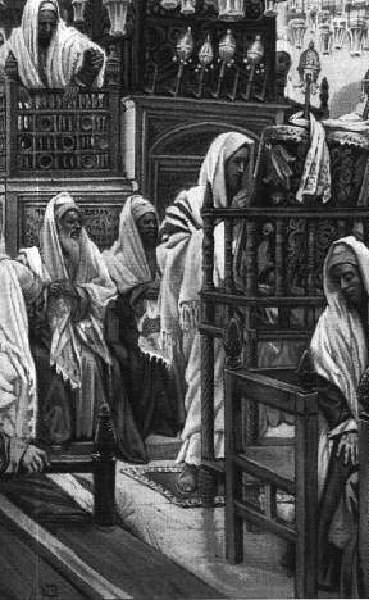
in the synagogue at Nazareth
Where Jesus obtained his education is not recorded in the Gospels or Church histories, but it is apparent that he was educated. Scholars know little about the availability of formal education for peasant or working classes in 1stcentury Judea and Galilee. Nazareth was a small Galilean village that went relatively unnoticed in the Old Testament, the pseudepigrapha, rabbinical literature, and early histories. As a result, many scholars claim that Nazareth did not exist at the time of Jesus and the Gospel accounts are again, little white lies based on a mistranslation of Nezer (Gr. Nazaraios) meaning Jesus was a "Nazarite" and not from Nazareth. Archaeological excavations show that Nazareth was occupied in the 7th century B.C.E. and apparently refounded in the 2nd century B.C.E. Robert North makes a good argument that the present town of Nazareth sits on the site of the Nazareth of Jesus. The Palestinian Talmud and the Babylonian Talmud relate that it was ordered by Simeon ben Shetah (103-76 B.C.E.) that every district and town have a Bet ha-Sefer, "School of the Book."The most likely source of Jesus’ education may have been the synagogue school in Nazareth. The family of Jesus could have afforded to educate the male children if a fee was charged. There were extensive building projects underway in Sepphoris and the "Ten City" region, which would have supplied sufficient income for a family of Tektons (building craftsmen). Another source would have been Joseph himself. Either through happenstance or design, we know next to nothing about Jesus’ father. I think it safe to assume, however, that Joseph was a very observant Jew, if not a Hasid himself. The beginnings of all of the bar Yosef boys’ educations would have begun with him. The extreme piety of Yaqub (James, the Righteous) and the other sons is testimony.
A few words from the Author:
Just a few personal notes to acquaint you with your scribe. I was born in Baltimore, Maryland on October 31, 1940. My passion for Biblical studies began very early and at age 8, I had my first Hebrew lessons from Bill Albright at Johns Hopkins University. Some time in early 1948, I had stopped by Dr. Albright's office and found him very excited over some photographs he had recently obtained of newly discovered scrolls. That day I had my first translational Hebrew exercise from the Dead Sea Scroll of Isaiah, 1Qs. I was hooked from that day to the present on ancient writing and manuscripts. Above any other archaeological artifact, nothing is as intimate to a personage of the distant past than his written word. Writing connects us to the past in a much more personal way than anything else left behind by society's enterprises. The sacred writings of Judaism, Christianity, Buddhism, Islam and those of all the world's great religions give us a direct handshake....or mind-shake, if you will, to the "saints" of a past when men felt closer to God. These writings are my passion; also my refuge from this time when men seem furthest from God...or at least the basic truths that should govern human behavior.
![]()
![]()
Disclaimer:
Some material presented will contain links, quotes, ideologies, etc., the contents of which should be understood to first, in their whole, reflect the views or opinions of their editors, and second, are used in my personal research as "fair use" sources only, and not espousement one way or the other. Researching for 'truth' leads one all over the place...a piece here, a piece there. As a researcher, I hunt, gather and disassemble resources, trying to put all the pieces into a coherent and logical whole. I encourage you to do the same. And please remember, these pages are only my effort to collect all the pieces I can find and see if they properly fit into the 'reality aggregate'.
Personal Position:
I've come to realize that 'truth' boils down to what we 'believe' the facts we've gathered point to. We only 'know' what we've 'experienced' firsthand. Everything else - what we read, what we watch, what we hear - is what someone else's gathered facts point to and 'they' 'believe' is 'truth', so that 'truth' seems to change in direct proportion to newly gathered facts divided by applied plausibility. Though I believe there is 'truth', until someone representing the celestial realm visibly appears and presents the heavenly records of Facts And Lies In The Order They Happened, I can't know for sure exactly what "the whole truth' on any given subject is, and what applies to me applies to everyone. Until then I'll continue to ask, "what does The Urantia Book say on the subject?"
~Gail Bird Allen
![]()
![]()



